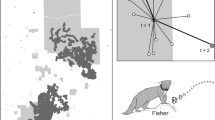Abstract
We develop and analyze a model that examines the effects of corridor quality, quantity, and arrangement on metapopulation sizes. These ideas were formerly investigated by Lefkovitch and Fahrig (1985) and Henein and Merriam (1990). Our simulations provide results similar to the Henein and Merriam model, indicating that the quality of corridors in a landscape and their arrangement will influence the size of a metapopulation. We then go one step further, describing how corridor arrangement alters the metapopulation, and provide a method for predicting which corridor arrangements should support larger metapopulations. In contrast to the Henein and Merriam model, we find that the number of corridor connections has no influence on the size of a metapopulation in a landscape unless there is an accompanying change in the uniformity of the distribution of corridor connections among patches.
Similar content being viewed by others
References
Adler, G.H. and Wilson, M.L. 1987. Demography of a habitat generalist, the white-footed mouse, in a heterogeneous environment. Ecology 68: 1785–1796.
Barnum, S.A., Manville, C.J., Tester, J.R. and Carmen, W.J. 1992. Path selection by Peromyscus leucopusin the presence and absence of vegetative cover. J. Mammal. 73: 797–801.
Bennett, A.F., Henein, K. and Merriam, G. 1994. Corridor use and the elements of corridor quality: chipmunks and fencerows in a farmland mosaic. Biological Conservation 68: 155–165.
Dunning, J.B., Danielson, B.J. and Pulliam, H.R. 1992. Ecological processes that affect populations in complex landscapes. Oikos 65: 169–175.
Fahrig, L. and Merriam, G. 1985. Habitat patch connectivity and population survival. Ecology 66: 1762–1768.
Forman, R.T.T. and Godron, M. 1986. Landscape Ecology. John Wiley & Sons, Inc., New York, Chichester, Brisbane, Toronto, Singapore. 619 pp.
Gaines, M.S. and McClenaghan, L.R. 1980. Dispersal in small mammals. Ann. Rev. Ecol. Systemat. 11: 163–196.
Goldwasser, L., Cook, J. and Silverman, E.D. 1994. The effects of variability on metapopulation dynamics and rates of invasion. Ecology 75: 40–47.
Gotelli, N.J. and Kelley, W.G. 1993. A general model of metapopulation dynamics. Oikos 68: 36–44.
Gyllenberg, M., Soderbacka, G. and Ericsson, S. 1993. Does migration stabilize local population dynamics? Analysis of a discrete metapopulation model. Math. Biosc. 118: 25–49.
Hanski, I. 1994. A practical model of metapopulation dynamics. J. Anim. Ecol. 63: 151–162.
Henein, K. and Merriam, G. 1990. The elements of connectivity where corridor quality is variable. Landsc. Ecol. 4: 157–170.
Kozakiewicz, M. 1993. Habitat isolation and ecological barriers — the effect on small mammal population and communities. Acta Theriol. 38: 1–30.
Krebs, C.J. 1992. The role of dispersal in cyclic rodent populations. InAnimal Dispersal. pp. 161–176. Edited by N.C. Stenseth and W.Z. Lidicker Jr. Chapman and Hall, New York, 365 pp.
Krohne, D.T., Dubbs, B.A. and Baccus, R. 1984. An analysis of dispersal in an unmanipulated population of Peromyscus leucopus. Am. Midl. Natur. 112: 146–156.
Lefkovitch, L.P. and Fahrig, L. 1985. Spatial characteristics of habitat patches and population survival. Ecol. Modell. 30: 297–308.
Lorenz, G.C. and Barrett, G.W. 1990. Influence of simulated landscape corridors on house mouse (Mus musculus) dispersal. Am. Midl. Natur. 123: 348–356.
Pulliam, H.R., Dunning, J.B. and Liu, J. 1992. Population dynamics in complex landscapes: a case study. Ecol. Appl. 2: 165–177.
Szacki, J., Babinska-Werka, J. and Liro, A. 1993. The influence of landscape spatial structure on small mammal movements. Acta Theriol. 38: 113–123.
Taylor, A.D. 1990. Metapopulations, dispersal, and predator-prey dynamics: an overview. Ecology 71: 429–433.
Taylor, P.D., Fahrig, L., Henein, K. and Merriam, G. 1993. Connectivity is a vital element of landscape structure. Oikos 68: 571–573.
Terman, C.R. 1993. Studies of natural populations of white-footed mice: reduction of reproduction at varying densities. J. Mammal. 74: 678–687.
Wegner, J. and Merriam, G. 1990. Use of spatial elements in a farmland mosaic by a woodland rodent. Biol. Conserv. 54: 263–276.
Zhang, Z. and Usher, M.B. 1991. Dispersal of wood mice and bank voles in an agricultural landscape. Acta Theriol. 36: 239–245.
Author information
Authors and Affiliations
Rights and permissions
About this article
Cite this article
Anderson, G.S., Danielson, B.J. The effects of landscape composition and physiognomy on metapopulation size: the role of corridors. Landscape Ecology 12, 261–271 (1997). https://doi.org/10.1023/A:1007933623979
Issue Date:
DOI: https://doi.org/10.1023/A:1007933623979




